The River Kills When Angry
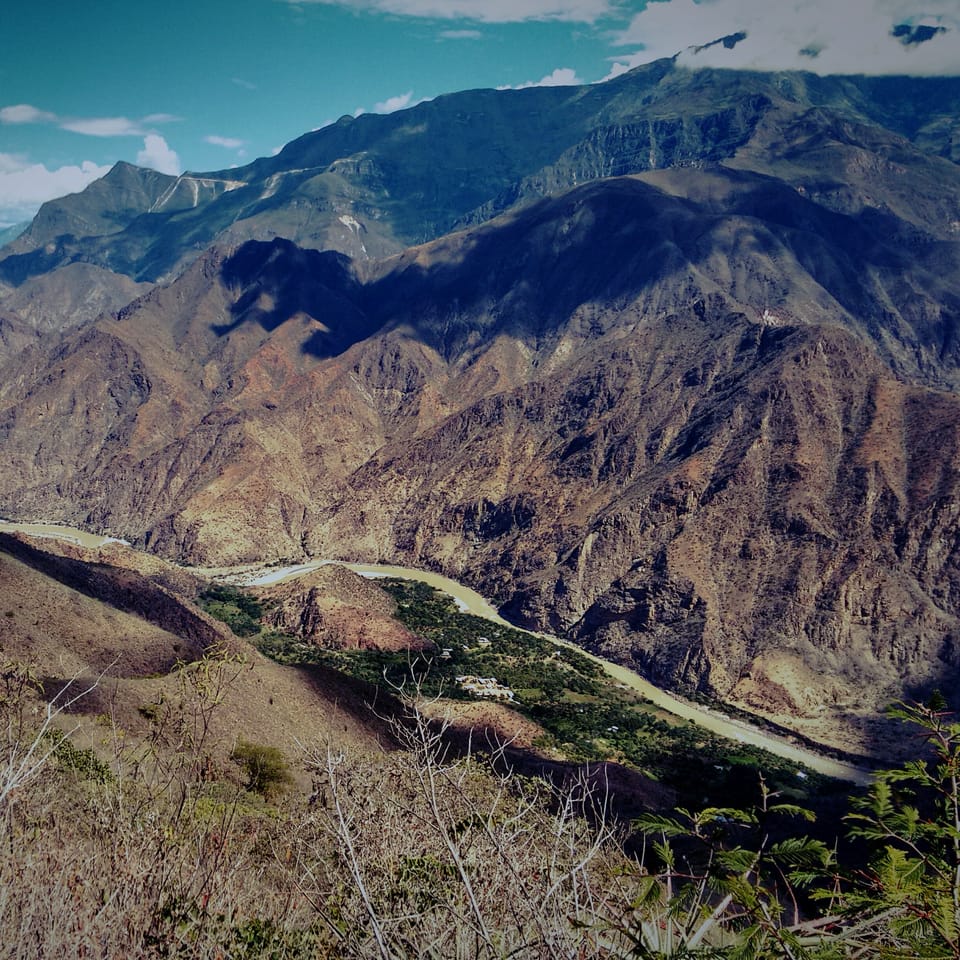
Saul here. I was living in Guatemala City when I got word that Arturo had drowned. I was months and thousands of miles away from Peru and the tragedy in the Grand Canyon of the Marañón, at the headwaters of the Amazon high above the jungle floor. I was working for Al Jazeera, living downtown in a hipster neighborhood by the courthouse, covering the war crimes trials, as aging soldiers were tried for the rapes and murders they had committed during the civil war.
Arturo was a 22 year-old whitewater guide in Peru’s mountain towns, which means he had one of the most dangerous jobs in the world. Peru, with its four mile-high mountain ranges draining rivers to the sea, is a world capital of adventure rafting and kayaking. Which — to put that another way — means that all day, every day Peruvian river guides go down terrifying rapids with totally unprepared crews of tourists and weekenders. This gives them a particular masculine confidence. Like many young guides, Arturo, was not phased by this fact. “The river is my father,” he would say during our fateful trip down the Marañón, “How could I not be safe here?”
Here’s how: That April 2016 I got an email: he had been escorting a group of weekenders down the Lunahuana River south of Lima . A young girl had flipped, and her kayak — a yellow boat that had played a starring role in the previous year’s tragedy — had been swept away.
Arturo sliced off alone in his kayak to follow it, around a blind curve. The other guides found him five minutes later, which in those circumstances was an eternity. He was wrapped around a bridge pylon, his hand around the kayak.
They buried him in his home village in Quillabamba, the Plain of the Moon, on the far side of the high Andes on the border between the mountain and the jungle. The news of his death was a stone dropped into a black pond, rippling outward to everyone who had traveled down the Marañón with me, and it eventually found its way to me.
Guatemala that winter seemed cloaked in a spirit of unquiet death. It mingled with the diesel and wood smoke choking the streets, clung to the tired working women on the school buses working their way downtown, stuck to the paunchy ex-soldiers and the Maya victims facing off in the Palace of Justice.
It was a ripple in the air that carried me back to Peru, back to the Grand Canyon of the Amazon, high in the Andes, at the great rapids above Samoscierra, where the whole affair began. And I began to write.
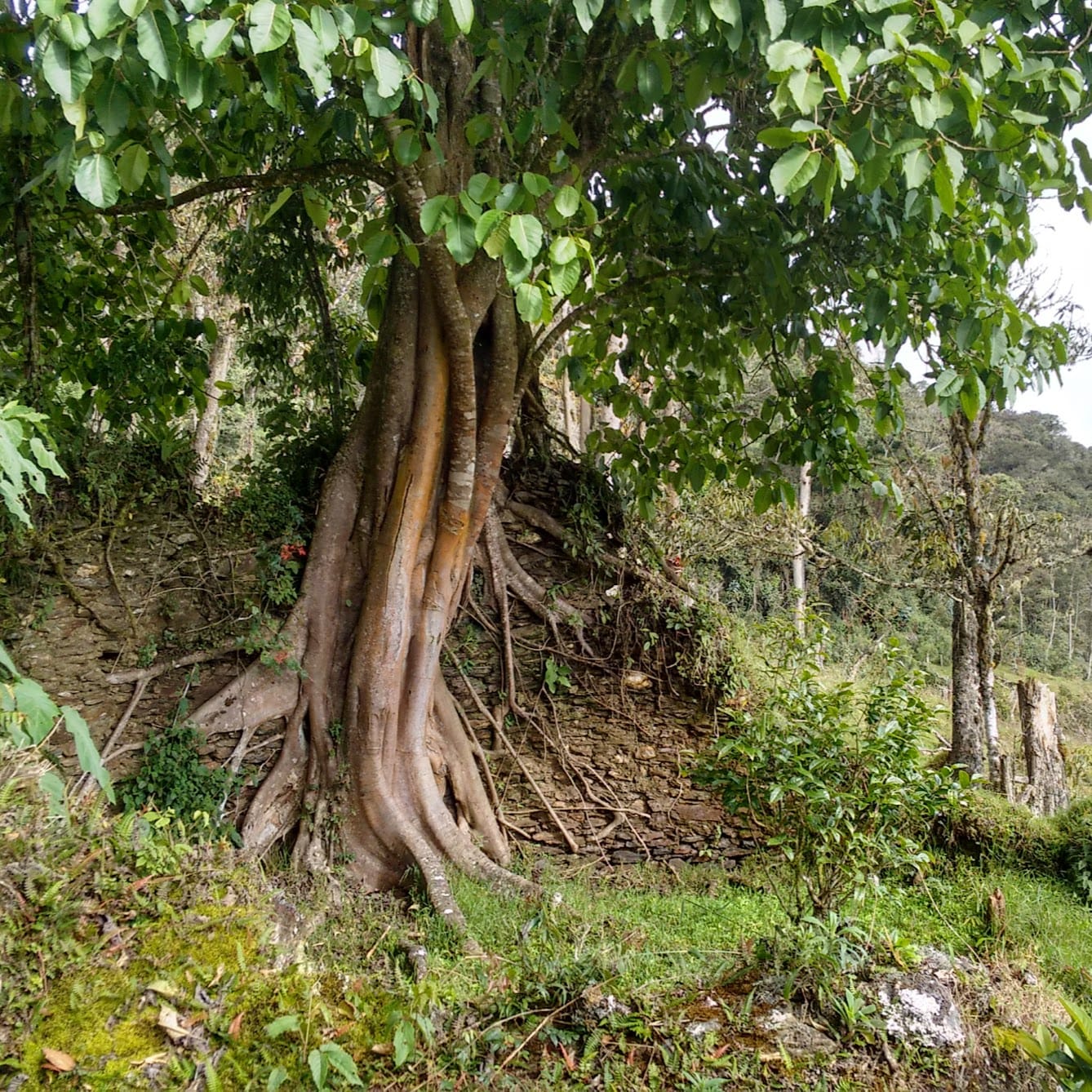
This is Heat Death, the newsletter that knows just what waits beyond the river bend. The story I’m about to tell you is one that has haunted me for more than a decade. In the summer of 2015, as a freelancer with Men’s Journal, I joined an expedition down the Marañón River, the main stream of the Amazon River, which cuts a half mile-deep canyon through the Andes — a beautiful and forbidding series of passages, punctuated by river towns that to this day feel like something out of Mark Twain.
In these river towns along its long descent, local villagers shuttle across the flat parts of the Marañón in crude rafts made of balsa logs bound together with bailing wire. These are terribly inadequate for the Marañón's dangers, which consist of unforgiving canyon walls, rapids as high as skyscrapers, and whirlpools large enough to swallow a bus. “What a feeble little structure, the raft, poised up on the roaring waters as on danger itself,” Ciro Alegria, poet laureate of the Marañón, wrote in the 1930s. “It carries the life of the Marañón man on it, and he stakes it on the toss of a coin.”
I had come to this expedition, and to the Marañón, because I had become fascinated with people who lived under the shadow of death. After college I moved to Guatemala City to cover the war crimes trials then beginning to take the city by storm. Every week, it seemed,troves of murdered bodies were being dug up in secret cemeteries in isolated valleys and beneath military bases, and paunchy, aging perpetrators of unspeakable crimes were being brought to sit in judgment at the Palace of Justice.
As an American, the open presence of death came as a shock, and when I came home to Texas I felt it clinging to me like a ghastly presence, a previously unseen dimension of life. In America we do not speak of death if we can help it; there are several suicides in my extended family but they were not discussed, and as I was growing up they hung over the family like ghosts.
So when I got invited down the Marañón, I jumped at the chance. There was an excuse for the trip — a dam project that threatened the river — but I was there because I wanted to walk up beneath that shadow and peer at it; I wanted to travel through a realm where unstoppable powers ruled.
Or at least, I thought I did.
So it was that in the summer of 2015, I found myself sitting with Arturo and three other Peruvian guides on an inflatable raft descending the main stream of the biggest river in the world, with the consequences of what that meant driven home to me by the fact that we were looking for the body of a fisherman drowned upstream.
This death, one of our other companions told me at the time, made sense. Elmer “Jhulinho” Huaman was a strong stocky kid from downstream who looked like George W. Bush might have, had the former president been an 18-year old mestizo Peruvian. When we'd caught word upstream that a valley fisherman was missing, Jhulinho had nodded.
“Makes sense,” he had said. “A high river is an irritated river, and it won’t calm until it takes someone. Well, that ought to have satisfied it. Look how it’s dropping.”
Wasn't it just statistically likely that the river would take someone at its highest, I asked? The guides treated this with the greatest disdain. “Hombre,” Enrique, one of the older guides, told me, “it's not a question of belief. It's a question of what happens.”
What I offer you now is a story that has taken me more than a decade to tell. I can’t tell you to believe it. I can only tell you that it’s what happened.
One last note: I'd like to thank Kit Rachlis, one of the finest editors I have worked with, for the yeoman's edit he did on this piece years ago.
This is Heat Death. Stay with us.
Heat Death is an entirely reader-supported newsletter, and all proceeds go toward paying guest writers and maintaining our web-hosting.
If you enjoy what we do here, please leave us a tip or sign up: paid subscriptions are just $2-$5 a month.
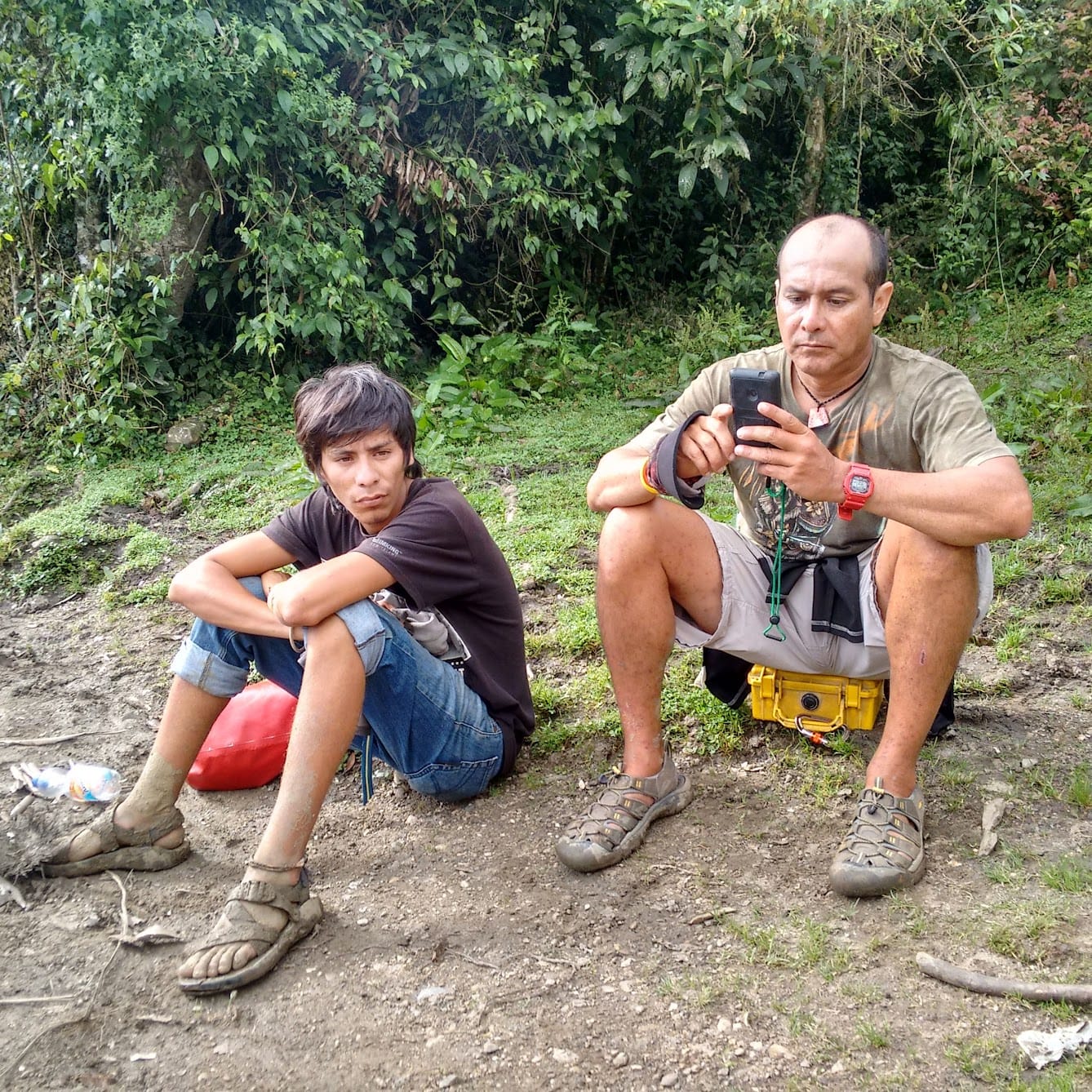
River Boys
Names with a * have been changed.
The sun was setting over the Marañón Valley when the expedition leader gave us the sign to row for shore. I was sitting in a twelve foot rubber raft, five thousand feet up the Peruvian Andes at the headwaters of the Amazon. Next to me was Elmer Huaman, universally known as Jhulinho, a stocky 18 year old kid from down the river who seemed made of pure muscle and bravado. Just below us we could hear the great rapids at Samoscierra growling like an angry beast.
In its four-mile fall from the glaciers atop the Andes to the Amazon floor below, the Marañón River comes at several places to enormous rapids, passed only with great caution. Samocierra was such a place, a kilometer-long labyrinth of subterranean rocks to flip a raft and complex currents to take a swimmer down. We pulled the raft up onto a sandy beach, through piles of driftwood, and left it alongside the other kayaks and cargo rafts with the expedition. Waiting on the beach was a dark skinned young man, 28, with long curly hair. Pablo Puñal*, the head Peruvian guide on our expedition down the Marañón River, from above the treeline down to the high jungle. Usually he bore an easy stoner smile. He was not smiling now. Upstream, one of the young guides had forgotten to tie off his cargo raft, and the current took it. Along with Puñal's personal kit, which – as it happened – contained his weed stash.
When he had realized it was gone he had shot off in his kayak without a word to anyone. “Okay,” he said, as soon as the rest of the expedition tied off their boats. A dozen guides, half of them Peruvian, half gringo, mostly in their 20s or early 30s, gathered around him. “Here's what we're going to do. The line down the rapids is going to go like this. We start on the left, and then there are huge boilers on the right, so we're going to have to go around those.”
He pointed downstream, plotting a route downstream in a slow, deliberate mix of English and Spanish, which he illustrated with lines drawn in the sand of the river with his index finger. The gringo guides' faces were tight and drawn. They were from the United States and had been raised on safety: on checking boxes to make sure nothing went wrong, and seeing it go wrong anyway. They could see it was getting dark. What if they lost another raft? Puñal, whose kit bag was still below, fairly vibrated with irritation.
The gringo guides walked off to consult. Puñal held court among the Peruvians. “Give them a break,” one guide said. “They're tired.” Tired, Pedro spat, rolling his eyes. “Tired of what, mi huaique?” he asked. “What did they even do today? No, what they are is frightened.”
If so, it was hard to blame them. The river below abounded with potentially lethal obstacles. On the first day, Puñal and the expedition's leader, Nathaniel Wren*, a 26 year old Australian, had made Jhulinho and me — the only two amateurs on a team composed almost entirely of professional guides — jump in and swim white water. It had hit my back like a freight train, sweeping me downhill with irresistible force. “If you fall in,” Wren deadpanned, “when you get to shore, make sure you swim up until your balls scrape on the ground, and then crawl out.”
Why? Because if you try to stand up when it's shallow enough, you can hook a foot on a rock and the hydraulic pressure will force you down and drown you. Then there were the boilers, where water moving over an underwater boulders bursts up like fountains that can trap and flip a raft; the whirlpools; the tricky eddy lines where currents meet; the undercuts where the river gnaws away at the canyon walls, creating an underwater chute which can swallow an unlucky swimmer.
To make matters worse the canyon system is always in flux: the walls calving slowly downward, side streams disgorging boulders into rapids that move, season by season, like food through a gut. As the first expedition downstream that season, we literally did not know what we were heading into.
I had come down for a men's magazine to write about dam projects that would flood the canyon, and was just beginning to realize the magnitude of what I had gotten myself into. A couple of days before, we had come to the market town of Calemar to find a drowned fisherman stretched out in a launch. The town drunk, his teeth spattered with bits of chewed coca, had promised us a good burial if we capsized, and his braying laugh had followed us as we floated downstream from Calemar. The great Calemar writer Ciro Alegria called his book on the Marañón El Serpiente de Oro, the Gold Serpent, and three days down the canyon it had begun to feel like we were working our way down through the grasp — or gullet — of a great beast. This, at least, was how the Peruvian guides treated it: a fistful of coca leaves on the water every morning, an offering to the being that bore us on its back.
Now, on the drift-spattered bank, the rapids growled over the muttering of the guides. I turned to Jhulinho. He and I were the only two novices on a trip composed nearly entirely of professionals — but he had grown up on the river, a couple hundred miles downstream where the Marañón enters the top of the high jungle, what locals call the seja selva, the eyebrow jungle. He was there as training: he wanted to be the first ever native guide on the Marañón River, and this was his first serious expedition.
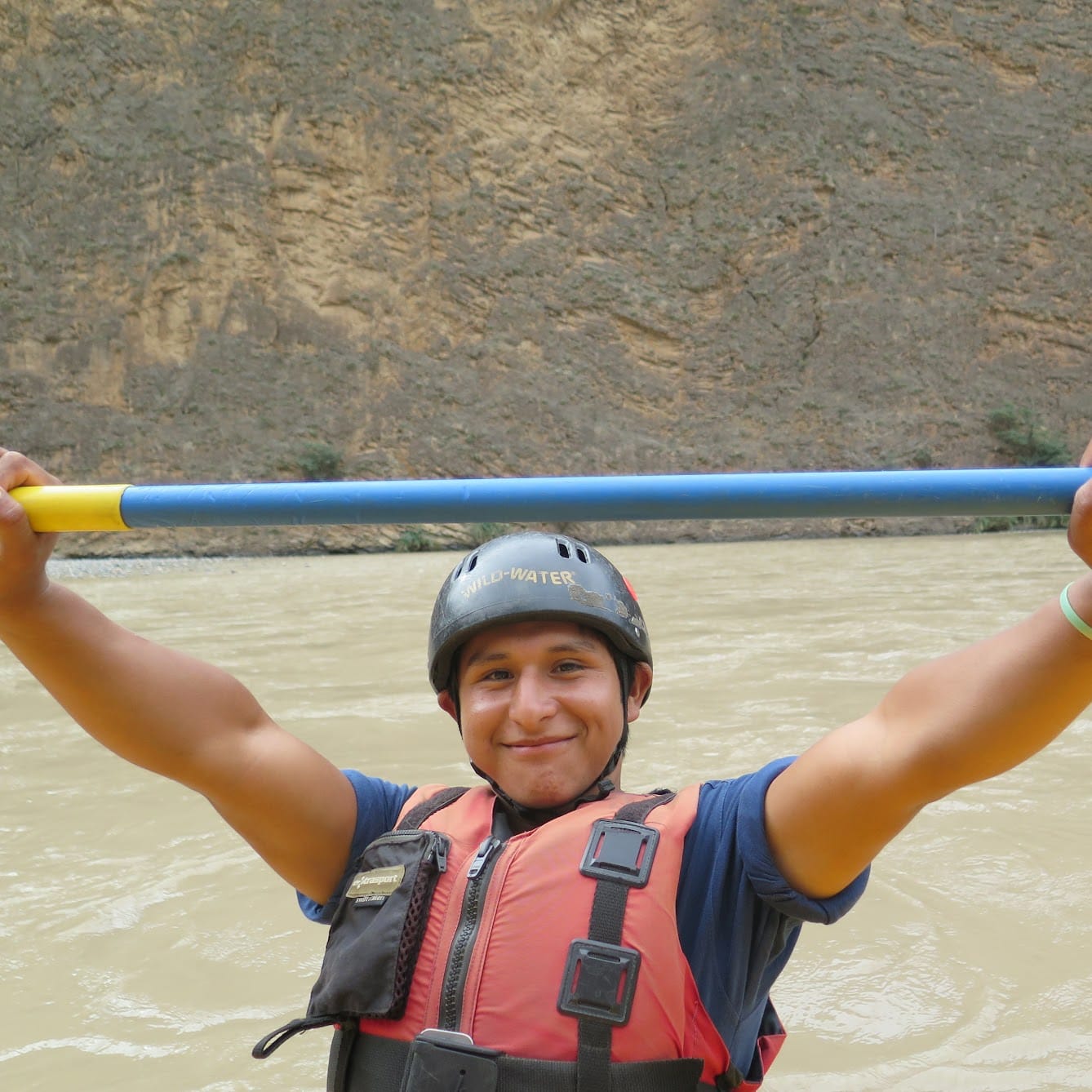
“Wanna run it?” I asked.
He shrugged. “All the same to me, huaique.” That last word — “brother” in Quechua, the imperial language of the Inca — bespoke his origins: his people were Quechua-speaking escapees from the highland estates who had settled the steamy river valleys in the early 1900s. (His last name, Huaman, means “falcon” in Quechua). Jhulinho was a second-generation native of the river valley, and he had grown up swimming in the river that, not infrequently, swallowed rafts and people whole.
This had not left him with much fear of it. To Jhulinho, the forbidding canyon of the Marañón was home. “And what could happen to me in my home?” he asked, whenever I teased him, asking if he was scared. He had swum the river, his father bragged to Wren, the expedition leader, a hundred times.
While the two halves of his crew debated whether to stay or go, Wren stood off to the side and watched Jhulinho. Below this apparently simple tactical decision lay a more complicated question, the fundamental problem of being a guide. How to handle risk and decision-making in a situation — a fast-moving and dangerous river — where things can quickly move out of control, converging into chaos. How is this to be handled? When you come to a place where you're in the grasp of larger forces, do you stop, wait, rest? Or do you go for it?
Puñal, the head guide, was the poster boy for going for it. At 28, he was a swaggering leader among the raft and kayak guides in Lunahuana, a mountain town popular with tourists from Lima; he knew the treacherous passages of the Upper Marañón probably better than anyone alive. He was supremely competent, and supremely confident in his own competence — what paddlers call a cowboy, prone to charge into the teeth of a rapid, paddles blazing. As he laid out the plan, it became clear that he had already run the rapid once — him and an 18-year old Argentine who Wren had sent after him when he ran off in his kayak. Traditionally, when rafters on an expedition come to a large rapid, they “eddy out” to the calmer waters at the side to look at it, plotting a line through its obstacles. Had they had any discussion of strategy before running Samocierra, I asked the Argentine later. “Sure,” he said — Pedro had turned to him, yelled Sigame, (“Follow me!”) and dove into the rapid.
Wren was cut from different cloth. He had quit his job as an environmental engineer to come to explore the Andes' rivers. When he discovered the Marañón — and that the Peruvian government planned to flood large swaths of it for hydroelectric dams — he began organizing hearts-and-minds trips to bring young Peruvian activists and filmmakers from the cities to see the threatened river. Where Puñal was impulsive, Wren was cool, even-tempered, a bit goofy, with a bone-dry deadpan. (Once, seeing me kill a mosquito, he said, “Oh, Saul, I thought you liked mosquitos,” then when I looked at him in confusion he grinned and said “Let enough in the tent last night.”) Where Puñal was prone to trust luck and skill, commending himself to the elements, Wren believed in rigorous, methodical planning.
Both, in other words, understood that a river is an unstable and dynamic situation, colossally more powerful than you are — but they differed on what to do with that fact. The hardest thing about learning to run whitewater, Wren thought, was keeping in mind that however good you thought you were, the river was always in control, always ready to throw you something unexpected. “Accidents on the river,” he liked to say, “tend to compound.” Mistakes cascaded like stones rolling downhill, a tiny error leading to a landslide. To Wren, being a good guide meant playing defense: never giving the river the chance to take the initiative. That meant being a fundamentalist about safety, and resisting the urge to act impulsively. Even if you're flipped underwater in a kayak going down a rapid, you don't panic. “You're cool as a cat,” he said, demonstrating how to roll a kayak back over. “You have all the time in the world.”
Now Wren, diplomatically, told Pedro he was willing to run the rapid, but he couldn't make anyone do anything. Said that personally he would advise waiting. Given that the gringos refused to move, Pedro stalked off to run the rapid yet again and recover his bag.
Puñal's decision to run the rapid worried Wren, because of its potential influence on Jhulinho. The example of a cool older guide running a set of rapids blind to just to rescue gear — that was a potential first rock in a cascade. A safety hazard, best avoided. That night, as we camped on the beach above Samoscierra, Wren sat with two older Peruvian guides, explaining to Juhlinho that while what Puñal had done was cool, he had taken a stupid risk. “In my tradition,” Wren said, “you get more credit for the rapids you portage, or walk away from. That’s when you really demonstrate your skill as a guide.”
Jhulinho seemed less than persuaded.
The next morning, going down Samocierra, I saw the careful approach in action.Wren planned the descent of Samoscierra like a military campaign. He and the other guides surveyed the shifting rapids, drawing diagrams in the sand. Wren placed the kayakers at eddies upstream where they could sweep the rapids to chase a raft that got lost. Again and again, he advised caution: if anything goes wrong, we stop and reset the safety. “We have all day to do this,” he said. I rode down in a raft with Julinho, commanded by Puñal, who seemed slightly bored by the whole thing. Midway through the rapid Puñal ordered us, as we whooped from adrenaline and icy water, into a riverside eddy, and produced a joint, passing it around as the water thundered by beneath.
It seemed clear which approach had more effect on Jhulino. He and the other young cowboy guides shared an intimacy built on a dense matrix of inside-jokes and unending shit-talk and pranks, all under Puñal’s swaggering shadow. “On this expedition, we give each other shit,” Puñal had told Julinho. “The first day if you don’t like it, let us know — and we’ll find you another expedition.” Jhulino hadn’t needed much encouragement to take risks. He didn't hesitate to help, whether needed or not — more than once, scrambling up a cliff on some canyon hike, I'd feel Julinho's hands on my feet, unasked for but incredibly strong, boosting me up into the air. When I saw him on the cliffs above Samocierra the morning after his come-to-Jesus with Wren, I asked, “You scared?” and he laughed theatrically and said, “Not even of death, huaique.”

Day by day, we rode the river down toward Tupén, Pedro calling forward and back as we rowed, Julinho pulling behind me like a piston. Around us the land changed, the bare canyon walls giving forth cacti as the riverside villages lost their coffee and sprouted chocolate and coca leaf, mango and banana. By the time we saw Jhulino’s extended family waiting on the beach below Tupén, the air was hot and wet with the promise of the jungle below. After all his little cousins dogpiled him, and the rest of the expedition to boot, we climbed up through the coca fields into the town square. Alberto Huaman, Jhulinho's father, and the other men of the village militia stood in their green uniforms and rubber truncheons. Farmers all, they mostly grew the Andean cash crop trinity of cacao, coffee, and coca leaf, and most had balls of coca in their mouths, which they would inject, every now and then, with little bits of quicklime carried in gourds at their waist. (Coca leaf is legal in Peru, although much ends up on the illegal market; the effect of the drug is to make fatigue fall away.) The women brought us baskets of oranges, sweet pulpy cacao and mangos, along with fruits I had never seen.
These were proud cholos, ‘half-breeds,” whose ancestors had come down the mountains into the high river valleys that drain away from Peru proper, toward Amazonia below. The river valley had changed them into frontiersmen, hewing a living out of of a strange land. Tupén is built on the shores of quebrada, a fast sweetwater creek which provides the water for networks of gravity-fed channels that nourish the crops, as well as the unending silt that clogs those channels. Water and silt feed a land that bursts forth in oasis, the village air singing with creatures: the cries of bright birds up from the forest; mules braying in the distance like bellows; babies crying for the breast. It was easy to see what had entranced Wren about Tupén: things moved at human and animal speed, and the dominant forces on human life were primal — soil, weather, wind, water. The first time Wren had seen it, he told me, “I thought, this is what we should all be moving toward,” he said, and the dam companies “are going to destroy it.”
But there was something disquieting there too: the price for this close-to-the-land lifestyle meant living in uncomfortably close proximity to invisible and deadly forces. Just as Tupén's humans lived on pigs and chickens, other things preyed on them: mosquitoes, tuberculosis, the flesh-dissolving leishmaniasis. And then there were larger predators: the chullachaqui, who took the form of a traveler’s friends to lead them to a lonely death in the wastes; the tunche, the forest devil, who stole people’s minds; the nearby siren who drowned women but kept men. Most powerful of all was the river below, which gobbled livestock, people, even entire towns. There is a common belief in the river valleys of Peru that when the river is high and rain-swollen, it is angry. And it will not rest until it takes someone.
The river folk lived involuntarily, in other words, in a world charged with death. There was not a guide who hadn't lost friends. Puñal wore a sticker on his helmet for Juanito, a young hotshot Peruvian kayaker, the best of his generation, drowned by a waterfall in Chile. Felix Nilsen*, a big 22-year old from Oregon with haunted eyes, started kayaking after a sneak ocean wave drowned two of his friends right beside him. “I’m terrified of water,” he said, “but I get to face my biggest fear every day.” This pugnacious attitude mirrored that of the village men, who went armed against the dam companies and anyone in town who supported them. Surveyors who dared to come to town, the town's volunteer militia explained, were made to do humiliating physical exercises, or rolled out on the cable car to the middle of the river and left there. When they found the schoolteacher was on the dam payroll, they beat him and ran him out of town. “They’ll fight the dams with guns if they have to,” said the new schoolteacher, his eyes shining.
The last night in Tupén I sat with Julinho and his mother Inez, eating macaroni soup by candle-light. Inez had been excited to see her eldest son, but also troubled. Below Tupén, we would come to a section where the Marañón, gorged on lesser rivers, entered a narrow cannon punctuated by enormous jungle whirlpools, or pongos; below that were the lands of the Awajun people, where the power of the government in Lima petered out and the valley cholos went only in mortal fear. All that week before our arrival, Inez had been disturbed with strange dreams. On a walk to a neighboring town, she had smelled the odor of death on her hands, though she had touched nothing, and was unable to wash it off. That night in Tupén she begged Julinho to stay. He just laughed. “Ay mama,” he said, “I don't believe in any of that bullshit.”
His parents embraced him tearfully as we pulled out of Tupén the next morning, our party weak from a tiny predator that had attacked us in the night, causing diarrhea and vomiting. Jhulino had promised his father that he would stay out of the pongos. Perhaps he had even meant it. But if so, the momentum of the journey must have sped him on, because when we entered the pongos he was still with us.
And that’s where everything went wrong.
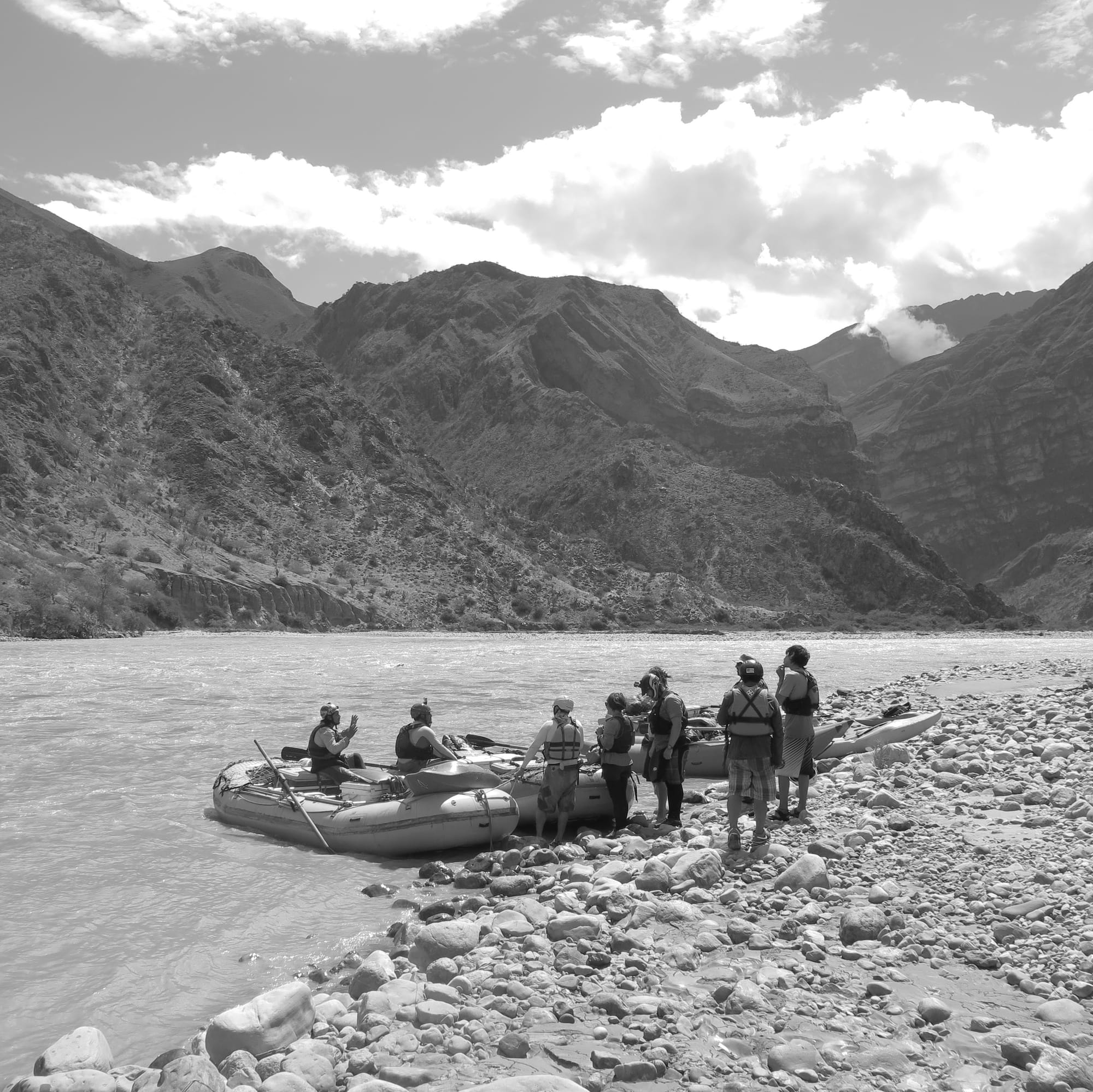
The Machiguengka people, in the Andean highlands due south, believe the world rose from a pongo, and that a pongo would someday swallow it. As we slid into the canyon a week below Tupén this was easy to believe. It was the last day of the journey and the very air felt sinister; a gathering heaviness that the usual handful of coca on the waters did nothing to dispel. Wren had woken up sick with worry but hid it well, running the boats tight down the passage, all the guides focused and alert as we passed between the steep valley walls, cutting between whirlpools that flexed and yawned over the surface of the water like stormclouds. Halfway through, a whirlpool flipped Nilsen, the kid from Oregon, pinning his yellow kayak upside-down in the churning water for a heart-stopping moment. Then he righted himself, ashen, and we fought our way to land, stumbling up punch-drunk from the giant whirlpool that swirls endlessly below the town of El Muyo.
We lingered for a time in town. A local restaurateur stretched out a chicken on the red dirt as village cats prowled around. She cut its throat with a few sure strokes, watching with a critical eye as it squawked through the hole where its head had been. “They take a while to die,” she said. We ate the chicken with fried cassava. And then a couple gringo kayakers made a terrible, fateful decision: they decided to run the village creek.
I should explain what this means. Like Tupén, El Muyo was built beside a fast waterway that sprang down from a break in the canyon, joining the Marañón below town. Though just 200 feet of whitewater, it had never been kayaked before, making it a rare prize: a chance at a first descent. Nilsen and two others hiked their kayaks up above town to run it, curious villagers tagging along behind.
But the creek was higher and faster than they anticipated. It flipped Nilsen quickly, dragging him over a set of falls upside, then another, tumbling him down, down, toward the full heaving bulk of the Marañón. At the last second he pulled free of his boat and swam for safety as his yellow kayak plowed into the Marañón and disappeared around the bend. Adrenaline pumping, Matt, one of the older guides, almost chased it before he caught himself. He had been a cowboy, he realized, dividing the group, charging down a creek he hadn’t scouted. At least Nilsen was okay. Let it go, he said, watching the kayak go. We don't risk our lives for gear. No need to let the mistake compound.
But events were already cascading.
When the villagers on the bank saw Nilsen dragged by upside down, an excited babble of panic rolled back toward town, to where I sat with Jhulino and the rest of the crew. Suddenly there were people all over the street, talking on top of each other. Someone flipped. Which one? The big one, in the yellow boat.
Alarm sparked in Jhulino's eyes. “Felix Nilsen!” he cried. He spoke no English but all the way down he and the bearish Nilsen had built up a relationship based solely on repeating each other's names,. Nilsen had helped teach Julinho to roll in his kayak. A village teen was standing there with his motorbike, and Julinho whispered in his ear and leaped onto the back.
The engine revved, and for a second he seemed to hang there, his eyes wide and frightened. And then they were gone, racing toward the Marañón.
Racing along the riverbank below town the two boys passed Nilsen's kayak, bobbing empty on the fast, flat water. There was no time to think. In seconds the kayak would be around the bend and lost. Jhulino had no helmet or vest, and he was alone. There was only one question: go, or don't go. His guide training demanded he stay out of the water. But in that moment he was not a guide: he was a river boy on the water of his birth, powerful and in full control, unafraid even of death. Hadn’t Puñal run Samoscierra, gaining glory by saving that raft? The kayak flew towards them. He stripped off his clothes and dove into the water. In a few powerful strokes he gained the kayak. He was paddling it like a surfboard, the teen explained, when he went around the bend.
What Julinho did not know — what Wren and the rest of the team only discovered when he did not return, and they ran the river looking for him — was what lay around that blind corner.
Just past the turn lay a line of ugly ugly whirlpools ending in a sieve, a place where fast water shot through underwater rock piles, trapping anything solid. Wren could see it immediately in his mind: Jhulinho, struggling with Nilsen’s waterlogged kayak, coming around the bend and flying right into that line. “With a helmet and life jacket,” he said, “maybe you’d have a chance. Without it …” They found the kayak bobbing downstream in an eddy. There was no sign of Jhulino.
The team ran the river down to the nearby market town of Bagua Grande and set up in a hotel to coordinate the search. “What happened?” Inez demanded, sobbing, hoping, when the team picked her and Alberto Huaman up at the Bagua bus station. “You said you’d protect him.” Wracked with guilt — for dividing the group at El Muyo, for bringing Puñal along to serve as a bad example — Wren was determined to find Jhulino, dead or alive. Sitting in a two-star hotel in Bagua, we discussed plans, including a raft run into Awajun country, where boatmen were sometimes murdered. Wren paid for a radio message to the lower river towns.
But really there was only one thing to do: wait, and hope, as for three days the grim clock of human decomposition ran down, and Jhulinho’s body, bloated and broken by rocks and rapids, made its slow journey up to the surface.
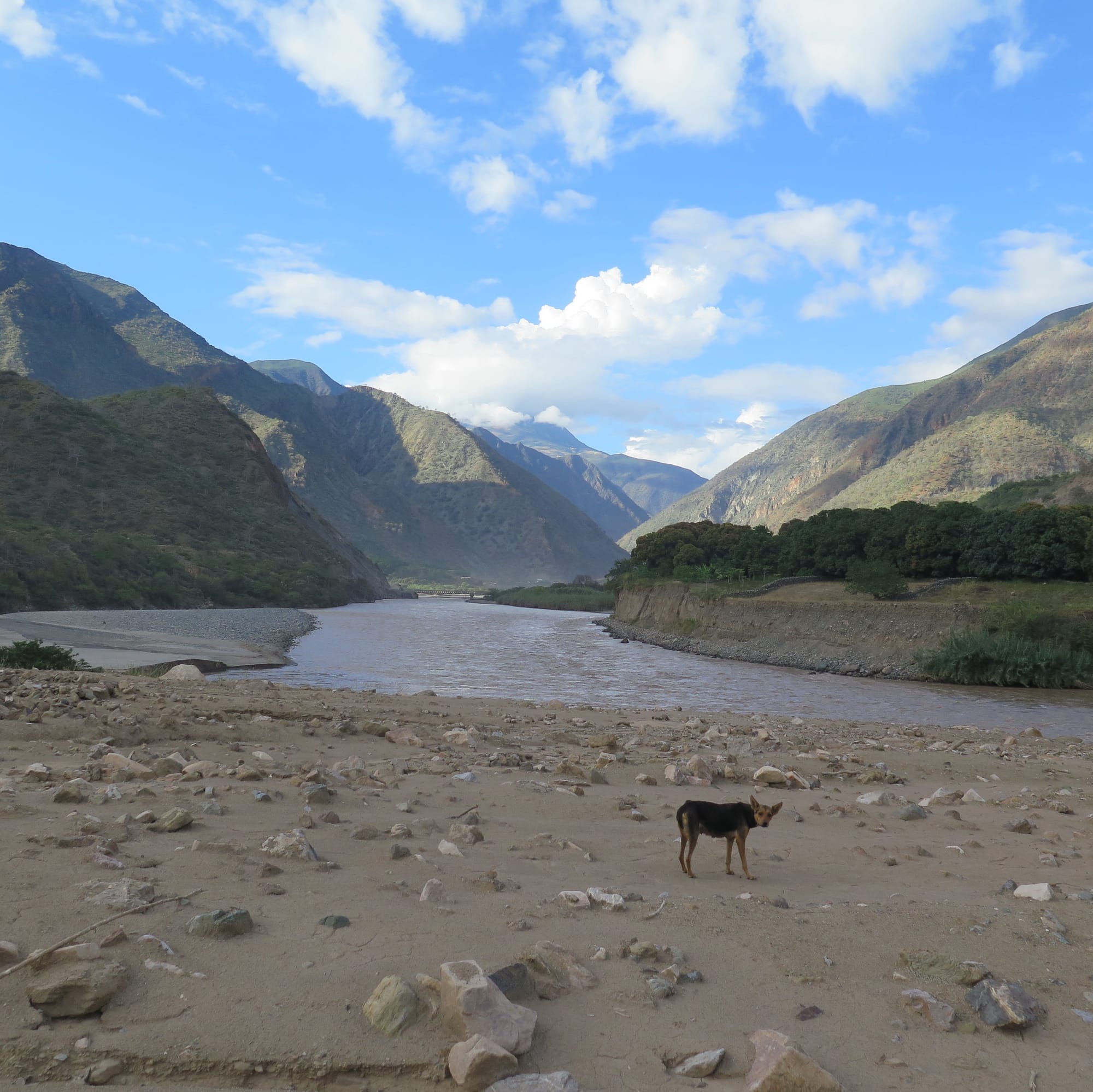
Almost exactly three days after Jhulinho's disappearance Wren got a call: his body had appeared in one of the usual eddies downstream. The news brought a strange relief: now, at least, everyone knew what to do. The following night we sped off in two rented black Toyota Hiluxes, Jhulinho’s coffin on the roof stuffed with three kilos of roast coffee against the smell. Where the road ended, at a coffee-farming town just below the canyon rim, we found most of the village of Tupén, waiting silently to carry his body home.
Inez' outburst aside, there was little talk of blame. Fate, everyone agreed, that’s what it was. Thank God, at least, that we found his body. Within hours of his arrival, Jhulino's passing became increasingly unmoored from the normal laws of cause-and-effect, becoming an island in the river of time. Numerous sources testified to an estuarial intermingling of Jhulino's life and death. There had been his parents' premonitions, and Wren’s. Arturo, Julinho's roommate at guide school, told how the morning he died Jhulino had woken up from dreams of his teeth falling out. “We said, careful, huevon,” he told Inez, “that's certain death. But he didn't listen.” Inez smiled. “Don't feel guilty,” she said. “He never listened to me either.”
And if he was half-dead while alive, he also seemed half-alive while dead. As his coffin lay in the casa communal people felt free to address him, scold him, lecture him. “Oh my son,” Inez chanted like a Gregorian, pounding on the box. “Why didn't you listen? For every night your mother had bad dreams.” The things his body was doing as it decomposed were spoken of in the same caring but hard-boiled terms they might use for babies with colic. On the day of the funeral Huaman stood with the other men dabbing coca, eyeing the sun rising in the sky, waiting for Jhulino’s sister who had quit her job in the Lima to come back for the funeral. (“I said, mija, take care of that job,” Inez said, with evident pride, “but she said, ‘it’s my brother who died, not some dog.’”)
“I hope she comes before his guts explode,” Huaman said. “Then things will be really bad.”
I watched them in this. In America, death is a force that we spend our lives denying; we shut our sick and dying away in boxes, and when we speak of death it is almost always as an avoidable accident, at which someone was at fault. Next time, perhaps, the doctor will do the right treatment; next time, the general will make a better call; next time, the government will pass a law so this will not happen again. And yet it continues to happen, and as it happens we are thrown up, just like the Tupéneros, against a mystery where our answers fail.
We have lost, perhaps, the idea of true tragedy: of death as something arising from the very fabric of being, that arises from the fact of our being alive. We have given this up, perhaps, because to accept it is to admit that there is no fundamental safety. “It was fated” is a comfort, but it is also a threat: it gives Jhulinho's last jump a terrible inevitability, as though whatever part of him had been conscious, there in those last moments beside the river, had been but a passenger aboard a train hurtling at brick wall, and all of it — train, tracks, wall — laid out long before any of us were born. As we waited for Jhulinho's sister to arrive I heard the whisper of the Marañón, rasping on the mountains, grinding it with silt that would flow forever, till the river dried or the mountains ground to dust, and I hear it grinding still.
They buried him in a churchyard above town, the whole village following behind the coffin with Chinese smartphones up and filming, a stream of people that overflowed the narrow trail and flooded the fields alongside, flowing over canals sweet with rotting mangos and oranges.
At the fresh grave Puñal and the other pallbearers lowered the coffin and guides and villagers scrambled over each other in a fury of movement, throwing dirt and rocks into the hole until it was level with the ground. Then a strange thing happened. The last handful of dust brought a sudden strong wind which carried plumes of sand, shaking boughs from the mango trees as thunder rolled in the storm clouds above the canyon wall.
A story swept through town: that two old men sitting on the hill had seen the sandstorm form into a whirlpool which became the face of Jhulino, and he was smiling.
The kayak that Jhulinho died chasing was recovered well before his body was, and Nilsen left it in Peru to be donated to the Lunahuana raft guides. I don't know what happened to it after Arturo died.
There's a post script to this story which has always haunted me, which is that somewhere in the river miles upstream from that deadly pongo I had begun picking out a new song on Wren's old guitar, in the evenings after we'd made dinner when there wasn't much to do. I finished it on the morning the last day of the voyage, just before Jhulinho's death.
The chorus went:
If I go don't weep
River take my bones down
Turning on the whirlpool
Dancing on the new ground
Drifting in the cane leaves
Rustling in the night breeze
Rolling out your back door
Underneath the mango
Trees.
This has been Heat Death. We are an entirely reader-supported publication. If you like what we do here, please subscribe: paid memberships are just $2 t0 $5 a month. (Or you can always leave us a tip.)
Have an idea for a story? Pitch us!
We'll be back soon with more musings on past, future, and all the crises in between. Until next time, just remember – there's always something waiting around the riverbend.



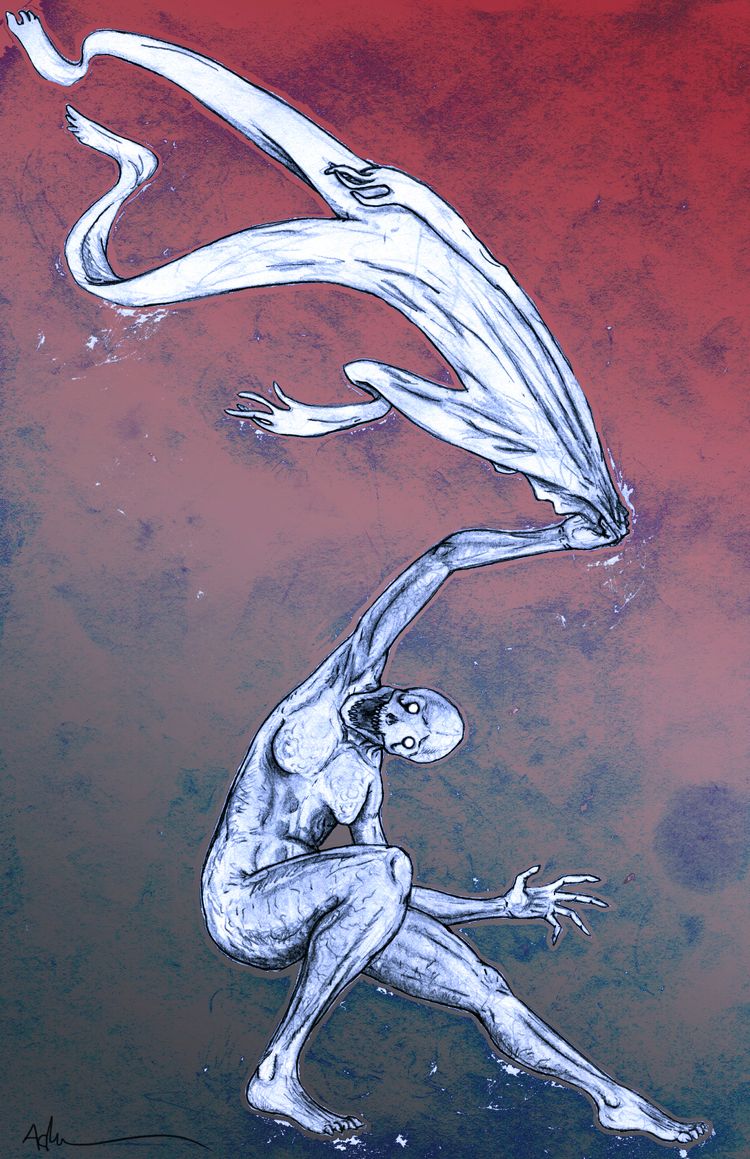
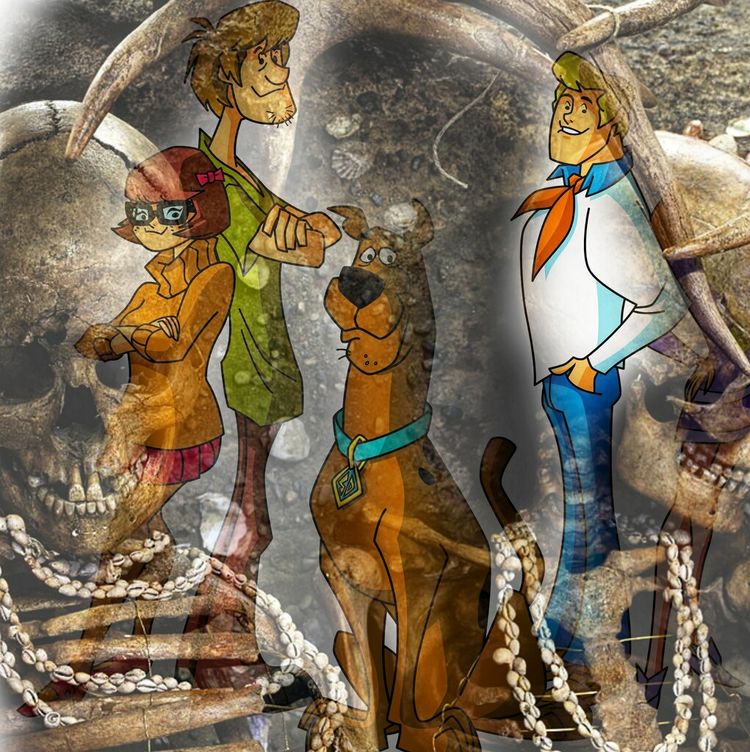
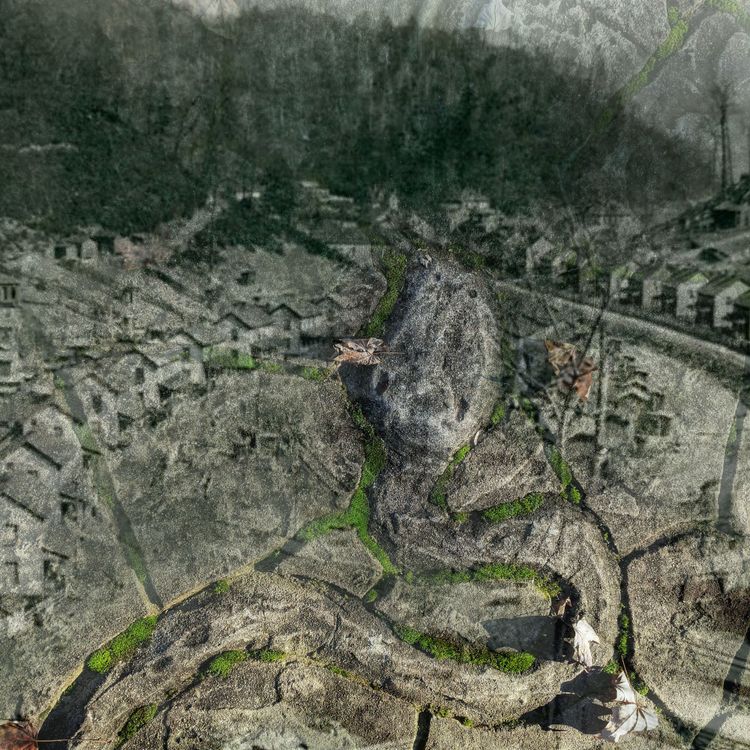
Member discussion